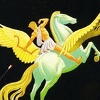



|
|
|
Title | Mythology
| |
Series | ---
| |
Author | Edith Hamilton
| |
Illustrated By | Steele Savage
| |
Publisher | Little, Brown and Company - ---
| |
First Printing | Little, Brown and Company - 1942
| |
Category | Mythology
| |
Warnings | None
| |
Main Characters
|
---
| |
Main Elements | Gods, monsters, heroes
|
|

The world-renowned classic that has enthralled and delighted millions of readers with its timeless tales of gods and heroes.
Edith Hamilton's Mythology succeeds like no other book in bringing to life for the modern reader the Greek, Roman, and Norse myths that are the keystone of Western culture--the stories of gods and heroes that have inspired human creativity from antiquity to the present. We meet the Greek gods on Olympus and Norse gods in Valhalla. We follow the drama of the Trojan War and the wanderings of Odysseus. We hear the tales of Jason and the Golden Fleece, Cupid and Psyche, and mighty King Midas. We discover the origins of the names of the constellations. And we recognize reference points for countless works of art, literature, and cultural inquiry--from Freud's Oedipus complex to Wagner's Ring Cycle of operas to Eugene O'Neill's Mourning Becomes Electra. Praised throughout the world for its authority and lucidity, Mythology is Edith Hamilton's masterpiece--the standard by which all other books on mythology are measured.

By the time I started on this classic book about the classics, I'd already been reading about five months worth of Greek and Norse mythology, including original sources like Homer or the Norse Eddas, with a few other things mixed in. Thus this book worked nicely as a recap of what I'd read so far.
Some things that made it different from the other books:
1 - Hamilton would explain what sources she used to put her version of the tale together. And where the source was primarily Roman, she would use the Roman naming, otherwise she'd use the Greek. I know a lot of people find that confusing but if you really want to be well educated in your myths, and to later recognize the references in the works of other authors such as Dante and Milton, you actually need to know the Roman version of things more than the origial Greek. Besides, I find it is mostly the name of the main Olympian gods you need to double up on, most of the heroes tend to keep the same or similar name.
2- She included Greek myths that didn't come up in my other sources, somehow Oedippus, famous as that tale is, didn't come up so far.
3 - I really like her "family trees" at the end, not the pictures of them but where she had a section on the House of Atreus, or The House of Thebes, helped to get me sorted out as to who is related to who. Because it was a glorious soap opera back then and everyone was someone's long lost relative, and with proclivities of the gods, everyone was half inbred (Odysseus could be related to Hermes on both sides of his family, some others have Zeus pop up more than one in his direct ancestry, for example father, but also great-great-grandfather, which a few Nymphs thrown in for variety). This was also the section that has the most "new" stuff for me.
The stories are truly complex, someone how is the protagonist in one tale can show up as a cameo in another. This too can be really hard to keep track of, Hamilton will remind you "Remember how we left Ariadne sitting alone on an island after Theseus abandoned her a couple chapters back? Well now in this tale of Dionysus, he discovers and marries her". It kind of drives home how all these myths really exist in the same world.
Hamilton also tries to give us a little background into the mind of the ancient Greeks and Romans, and how they were different (and how that altered the way the myths were told). I'm not so sensitive a reader I could tell the difference really when comparing say the The Iliad (Greek) with The Aeneid (Roman), but then I'm reading prose translation so I'm sure I lost the original tone of the poems somewhat.
The Norse section was absolutely tiny, not sure why it was even included, the telling of the tales were so necessarily brief and there were so few, and it wasn't even used to compare/contrast with the Greek/Roman myths much, felt like someone just had the chapter lying around and shoved it in.
But I felt this was a very good reference book. Keep in mind I did say reference, this isn't light reading and probably not intended to be read cover to cover in one sitting, your brain will overflow with names, places and events. But it worked ok for me since I was already familiar with the vast majority and something I can use when I forget certain characters or stories.
|